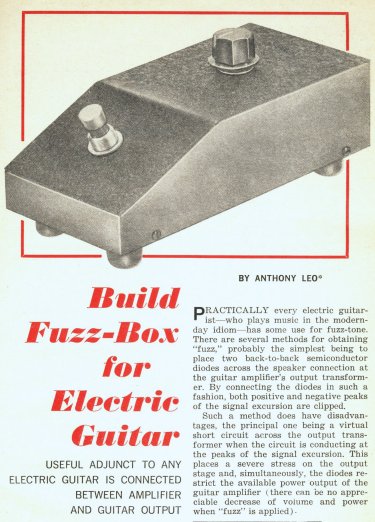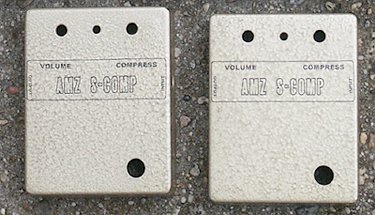
Bob Sweet, maker of the Mojo Vibe, Ultra Vibe and other excellent pedals, has been diagnosed with cancer. He has a tumor that is malignant and will need to be removed and treated with chemotherapy, and radiation. Bob does not have medical insurance and the treatments that he requires will be very expensive and have already taxed Bob and his wife financially.
I ask that you donate what you can to help our friend, so please send a Paypal contribution to his email address at b0bsweet@bellsouth.net. Every little bit helps with Bob’s medical bills as he continues his treatments.
I am sure that many of us have had family members and friends that have battled this disease.
Musictoyz has established a Bob Sweet Charity page for information and updates.
My contribution has been sent. Please help if you can. Many thanks in advance!
(more…)

Leo’s Fuzz from Pop Electronics
(more…)

Germanium transistors are back!
I found some really nice 2N404A germanium transistors with low leakage and gold leads. Also have some 2N1309 mil-surplus that are high gain and very low leakage as well. All transistors are tested with a Peak Electronic Design Semiconductor Analyzer, and guaranteed to meet minimum gain and leakage specs.
I sorted a batch of AC128 transistors and tossed about 60% of them to get a few that are good enough for fx use… get them while I still have some available. All three types are for sale on the page at:
http://www.muzique.com/pcb.htm

Where do you place a compressor in the signal chain? This often asked question is actually an easy one to answer… the compressor goes first!
(more…)

Okay, you want to put together a fuzzface type circuit from items in your junk box and you don’t have the 1k pot for the fuzz control. What can you do?
A simple mod is to replace the fuzz control with a fixed 1k resistor – this sets the dc bias properly. Then connect the 22uF to the emitter of Q2 and use a 5k or 10k pot as a variable resistor to control the amount of distortion, as shown here.
The new larger value pot should be a reverse audio taper for best results but a linear will do if that’s all you have in the junk bin.
It is not the classic circuit but this can get you going on short notice when you lack the proper parts.

Anyone who has been using effects for any length of time knows that the Proco Rat is one of the most respected distortion pedals on the market. Did you know that it has its own web site? Check out the history of the different Rat models:
Proco Rat history
It even has its own Myspace page that is linked from its web site.
The Rat is a heavy-duty fuzzbox that can take a lot of punishment and keep on working. It has a distinctive treble boost distortion that cuts through a cluttered band sound.
Buy one of the Rat pedals and then add some of the mods found in the AMZ eBook to customize it for your rig.

Here is the stripboard (veroboard) layout for the jfet buffer that is shown a few posts below. The board is 10×10 with no strip cuts necessary and only one jumper. If you plan to leave this on all the time, no footswitch is needed and you can put the project in a very tiny box. Link to the complete article is below:
AMZ Jfet Buffer article

Rodenberg Amplification has a series of pedals with some interesting features. The laser engraved stainless steel top plate is a nice touch too.
The 728 (shown here) can be used in a couple of different modes according to the switch settings. Another nice item is the jewel lamp over the indicator, which I have used on pedals before too. One of the rocker switches is used to flip the LED between bright and dim settings, which I’ve not previously seen on a commercial pedal.
The rocker switches also have integral led indicators to show when they are activated. All of these leds require that the pedals use an external power supply instead of a battery.
I don’t know anything about the circuitry but the text seems to indicate that some of the pedals are using a modded TS-808 topology.
There is a shot of the inside of the boost pedal and they seem to be well made.
Rodenberg GAS Pedals
 I’ve recently posted a tutorial on how to add a ground plane to a pc board layout using Cadsoft’s design software.
I’ve recently posted a tutorial on how to add a ground plane to a pc board layout using Cadsoft’s design software.
Also, a bonus is that I created a pc board to use for an example in the tutorial and ended up fleshing it out into a full project.
If you want to build a simple jfet buffer for use with your guitar effects, this project is up to the task. The article includes schematic, pcb layout and parts placements.
Link to the project is below:
AMZ Jfet Buffer and groundplane tutorial
 AMZ Goes Solar!
AMZ Goes Solar!
Here is a shot of my new solar battery charger connected to a rechargeable 9v battery. I’m using these special batteries for all of my pedal testing.
The charger came from Harbor Freight and cost $12.
The rechargeable 9v was found on Ebay.








 I’ve recently posted a tutorial on how to add a ground plane to a pc board layout using Cadsoft’s design software.
I’ve recently posted a tutorial on how to add a ground plane to a pc board layout using Cadsoft’s design software. AMZ Goes Solar!
AMZ Goes Solar!





